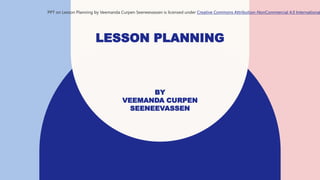
Lesson Planning for teaching art education at Secondary level.
- 1. LESSON PLANNING BY VEEMANDA CURPEN SEENEEVASSEN PPT on Lesson Planning by Veemanda Curpen Seeneevassen is licensed under Creative Commons Attribution-NonCommercial 4.0 International
- 2. AGENDA • Introduction of lesson • Aim • Learning objectives • Materials and Resources • Instructional Strategies • Assessment and evaluation • Differentiated Instruction • Reflection and Extension 2
- 3. AIM
- 4. • Defining aim: • The aim of a lesson or unit outlines the overarching purpose or broad goal of the instructional activity. • It provides a general direction and sets the tone for what students are expected to achieve or experience as a result of the lesson. • Aims are often more abstract and encompassing, reflecting the broader educational outcomes of the curriculum.
- 5. Example: Aim for teaching Colour Theory: "To develop students' understanding of the principles of colour theory and their ability to apply acquired knowledge in creating visually harmonious artworks." Example: Aim for Teaching Art Appreciation: "To cultivate students' appreciation and critical understanding of diverse artworks, artists, and art movements.” 5
- 6. OBJECTIVES
- 7. • What are objectives? • Objectives, are specific, measurable, and actionable statements that articulate the intended learning outcomes of the lesson or unit. • They describe what students should be able to do, demonstrate, or achieve by the end of the instructional period. • Objectives provide clear guidance for instructional planning, assessment, and evaluation. 7
- 8. • Aim: To develop students' understanding of the principles of colour theory and their ability to apply acquired knowledge in creating visually harmonious artworks." • Objectives: • Students will be able to identify primary, secondary, and tertiary colours. • Students will demonstrate the ability to mix primary colours to create secondary colours and other meaningful colour combination. • Students will analyse and describe the use of colour in artworks to convey mood, emotion, and meaning. 8
- 9. • Aim: “To cultivate students' appreciation and critical understanding of diverse artworks, artists, and art movements.” • Objectives: • Students will analyse and interpret artworks from different historical periods and cultural contexts. • Students will evaluate the formal elements and principles of design in selected artworks. • Students will articulate their personal responses and interpretations of artworks, drawing on evidence from the visual elements and contextual information. 9
- 10. E.G 2: TEACHING COLOUR THEORY 10 Objective 1: Students will demonstrate the ability to mix primary colours to create secondary colours through hands-on colour mixing exercises. Objective 2: Students will analyse and discuss artworks by artists such as Wassily Kandinsky and Josef Albers to explore the use of colour symbolism and emotional expression in art. Objective 3: Students will create a colour wheel or colour chart demonstrating their understanding of colour relationships, such as complementary, split complementary and analogous colours.
- 11. MATERIALS AND RESOURCES • Identify the materials, tools, and resources that will be needed for the lesson, including art supplies, technology, reference materials, and any other equipment necessary for student engagement and learning. 11
- 12. INSTRUCTIONAL STRATEGIES • Determine the instructional strategies and teaching methods that will be employed to facilitate student learning. • Consider a variety of approaches such as direct instruction, hands-on activities, demonstrations, group work, and discussions to accommodate diverse learning styles and preferences. 12
- 13. ASSESSMENT AND EVALUATION • Planning how student learning will be assessed and evaluated during the lesson. • Determining the criteria for success and considering formative assessment strategies such as observation, questioning, peer evaluation, and self- assessment to monitor student progress and provide feedback 13
- 14. DIFFERENTIATED INSTRUCTIONS • Take into account the diverse needs, abilities, and interests of students in the class. Consider how the lesson can be differentiated to accommodate various learning styles, abilities, and preferences, including providing additional support or enrichment activities as needed. 14
- 15. HISTORICAL AND CULTURAL RELEVANCE • Incorporate historical and cultural relevance of Art into the lessons. • Select art movements, artworks and themes that reflect the historical, contextual or artistic backgrounds, perspectives of artists. • Ensure that the content is inclusive and representative of various cultures, identities, and artistic traditions. 15
- 16. REFLECTION AND EXTENSION • Plan opportunities for student’s critical reflection. • Also use theoretical framework like the Revised Bloom Taxonomy to plan for extension activities beyond th elesson, to deepen understanding and promote higher order thinking skills. • Encourage students to reflect on their own artistic processes, achievements, and areas for growth. 16
- 17. ALIGNMENT WITH CURRICULUM STANDARDS • Ensure that the lesson plan aligns with relevant curriculum standards, learning objectives, and educational guidelines established by the school, educational institution and policy • Consider how the lesson contributes to broader educational goals and objectives within the art and design curriculum. 17
- 18. THANK YOU